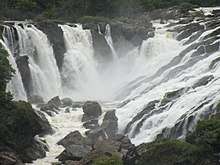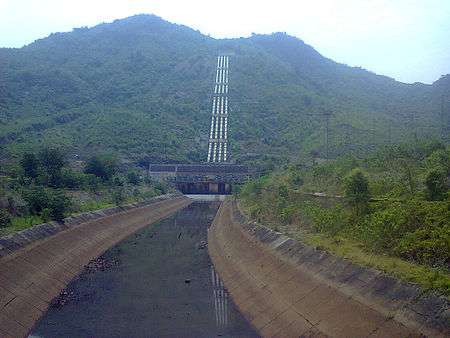Hydroelectric power in India
India is the 5th globally for installed hydroelectric power capacity.[1] As of 31 March 2020, India's installed utility-scale hydroelectric capacity was 46,000 MW, or 12.3% of its total utility power generation capacity.[2] Additional smaller hydroelectric power units with a total capacity of 4,683 MW (1.3% of its total utility power generation capacity) have been installed.[3] India's hydroelectric power potential is estimated at 148,700 MW at 60% load factor.[4] In the fiscal year 2019–20, the total hydroelectric power generated in India was 156 TWh (excluding small hydro) with an average capacity factor of 38.71%.
The hydro-electric power plants at Darjeeling and Shivanasamudram were established in 1898 and 1902, respectively. They were among the first in Asia and India has been a dominant player in global hydroelectric power development.[5] India also imports surplus hydroelectric power from Bhutan.
Small hydropower, defined to be generated at facilities with nameplate capacities up to 25 MW, comes under the ambit of the Ministry of New and Renewable energy (MNRE); whilst large hydro, defined as above 25 MW, comes under the ambit of Ministry of Power.[6][7]
Hydroelectric potential
India's economically exploitable and viable hydroelectric potential is estimated to be 148,701 MW.[8][9] An additional 6,780 MW from smaller hydro schemes (with capacities of less than 25 MW) is estimated as exploitable.[10] 56 sites for pumped storage schemes with an aggregate installed capacity of 94,000 MW have also been identified. In central India, the hydroelectric power potential from the Godavari, Mahanadi, Nagavali, Vamsadhara and Narmada river basins has not been developed on a major scale due to potential opposition from the tribal population.[11]
The public sector accounts for 92.5% of India's hydroelectric power production. The National Hydroelectric Power Corporation (NHPC), Northeast Electric Power Company (NEEPCO), Satluj Jal Vidyut Nigam (SJVNL), THDC, and NTPC-Hydro are some of the public sector companies producing hydroelectric power in India. The private sector is also expected to grow with the development of hydroelectric energy in the Himalayan mountain ranges and in the northeast of India.[4] Indian companies have also constructed hydropower projects in Bhutan, Nepal, Afghanistan, and other countries.[4]
Bhakra Beas Management Board (BBMB), a state-owned enterprise in north India, has an installed capacity of 2.9 GW.[12] The generation cost after four decades of operation is about 27 paise (0.38¢ US) per kWh.[13] BBMB is a major source of peaking power and black start capability to the northern grid in India and its large reservoirs provide wide operational flexibility. BBMB reservoirs also supply water for the irrigation of 12.5 million acres (51,000 km2; 19,500 sq mi) of agricultural land in partner states, enabling the green revolution in the northern India.
The International Hydropower Association estimates that the total hydropower potential in India is 660,000 GWh/year, of which 540,000 GWh/year (79%) is still undeveloped.[14] India ranks as the fourth country in the world by undeveloped hydropower potential, after Russia, China and Canada, and fifth by total potential, surpassed also by Brazil.[14]
Pumped storage units
India has transformed from an electricity deficit state to an electricity surplus state. Peak load shortages can be met making use of pumped storage schemes which store surplus power to meet peak load demands. The pumped storage schemes also contribute secondary, seasonal power at no additional cost when rivers are flooded with excess water. India has already established nearly 4,800 MW pumped storage capacity with the installation of hydropower plants.[15]
Pumped storage units can also be used as pumping stations to supply river water for upland irrigation, industrial needs, and drinking water. In a tropical country like India, abundant water for agriculture is needed due to a very high annual evaporation rate. The amount of water necessary to meet this demand can be harnessed from India's rivers via pumped storage units. Food security in India is improved with water security which in turn is possible from the energy security to supply the power needed for the pumped storage schemes.[16]
More and more solar power generation is becoming available at cheaper cost and it has advantage in terms of environmental impact.[17] Solar power can meet daytime and night time energy demands with the help of pumped storage units.[18][19][20]
Many of the existing hydro power stations on the west-flowing rivers located in the Western Ghats of Kerala and Karnataka are to be expanded to include pumped storage units in an effort to solve the water deficit of east-flowing rivers like the Kaveri, the Krishna, etc.[21]
See also
- List of hydro power stations in India
- Electricity sector in India
- Energy policy of India
- Pollution of the Ganges
- Water resources in India
- Indian Rivers Inter-link
- Wind power in India
- Solar power in India
- Biofuel in India
- Power sector of Andhra Pradesh
- Renewable energy in India
- Yarlung Tsangpo Hydroelectric Project
References
- "India overtakes Japan with fifth-largest hydropower capacity in the world". Retrieved 30 May 2020.
- "All India installed capacity of power stations, March 2020" (PDF). Retrieved 25 May 2020.
- "Renewable Energy Physical Progress as on 31-03-2020". Ministry of New & Renewable Energy, GoI. Retrieved 4 June 2020.
- "Hydro Electric Potential in India". Retrieved 17 April 2016.
- "India remains major competitor in global hydropower". Retrieved 17 April 2016.
- "Executive Summary Power Sector February 2017" (pdf). report. Central Electricity Authority, Ministry of Power, Govt. of India. 28 February 2017. Retrieved 24 April 2017.
- "Small Hydro". Government of India Ministry of New and Renewable Energy. Archived from the original on 2018-02-20. Retrieved 6 April 2019.
- "Status of Hydro Electric Potential Development in India" (PDF). Retrieved 17 April 2016.
- "Hydropower - Too slow to be steady". Retrieved 17 April 2016.
- "Govt plans push for hydro power". Retrieved 17 April 2016.
- "River basin wise hydro potential in India, CEA". Retrieved 23 June 2017.
- "AN OVERVIEW OF HYDRO-ELECTRIC POWER PLANT (PDF Download Available)". ResearchGate. Retrieved 2017-02-21.
- "See page 33, Executive Summary for the Month of May, 2016" (PDF). Retrieved 7 July 2016.
- "World Energy Resources | Hydropower 2016" (PDF). World Energy Council. Archived from the original (PDF) on 6 August 2018. Retrieved 6 August 2018.
- "Pumped storage hydro power plant" (PDF). Archived from the original (PDF) on 7 July 2014. Retrieved 27 August 2014.
- "Water and food security | International Decade for Action 'Water for Life' 2005-2015". www.un.org. Retrieved 2017-02-21.
- "Solar power tariffs drops historic low at Rs 2.44 per unit". Retrieved 21 May 2017.
- "Why The Renewables Revolution Is Now Unstoppable". Retrieved 27 June 2016.
- "Geographic information system showing prospective sites for pumped hydro energy storage in India". Retrieved 19 November 2019.
- "Elon Musk Should Build Pumped Hydro With Tesla Energy, The Boring Co., & Coal Miners". Retrieved 27 October 2019.
- "India readies plan to improve renewable power storage". Retrieved 22 August 2016.

